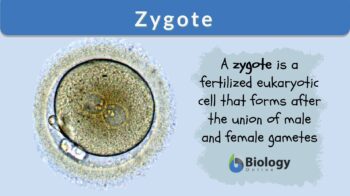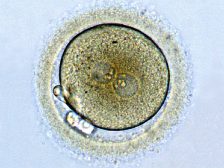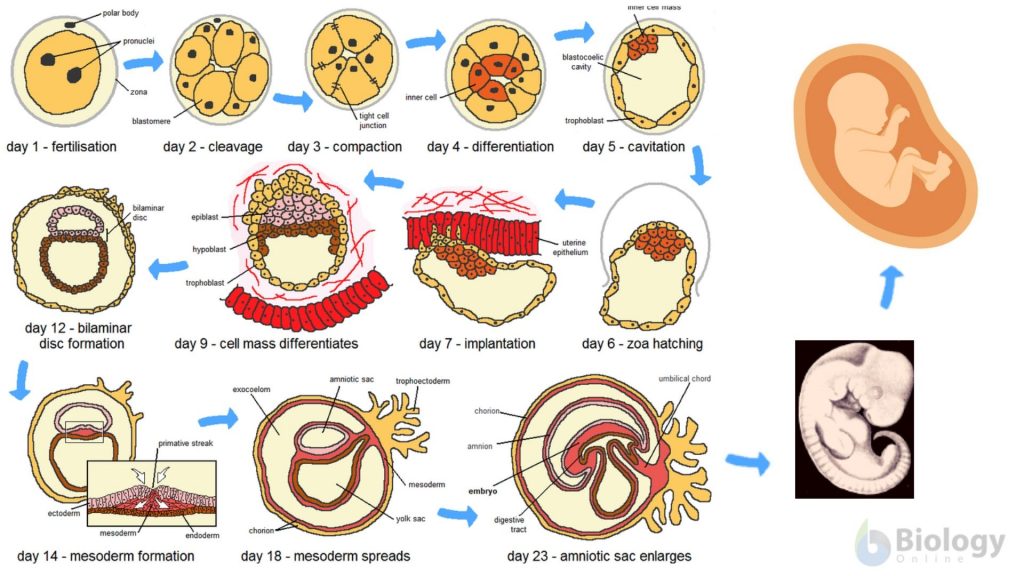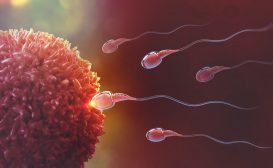
Zygote definition:
n., plural: zygotes
A fertilized eukaryotic cell; a cell after the union of male and female gametes
Table of Contents
Zygote Definition
What is a zygote? A zygote is a fertilized eukaryotic cell. In biology, medical science, and other allied fields, including psychology, the term “zygote” is used to refer to a cell that forms after the union of sex cells (also called gametes). Reproduction by sexual means involves male and female gametes. In humans, the male gamete is the sperm cell and the female gamete is the ovum (also called the egg cell). Both of them are haploid (n). Their union will result in a zygote that is diploid (2n) and by a process called fertilization. This newly formed single cell, then, undergoes a series of mitotic divisions and grows into a multicellular form. The cells that sprung from the zygote will essentially have the same genetic composition throughout the body but eventually will acquire a special role or a distinct function as they are organized into tissues, organs, and systems.
Etymology: from Greek zugōtos ‘joined’, from zugoun, meaning “to join”.
Synonyms: zygocyte.
Sentence example: The human zygote forms after fertilization and grows into an embryo when it starts to divide.

In the above picture, the pronuclei from male and female gametes at the center have not fused yet. The cytoplasm of the ovum contains cytoplasmic organelles, such as mitochondria that account for the extranuclear genome. The cell is surrounded by an extracellular matrix layer called zona pellucida (a protective outer membrane). Notice the circular structures at the periphery tangential to the longitudinal axis. They are the polar bodies produced by the second meiotic division.
Gamete vs. Zygote
Both “gamete” and “zygote” are common terms in biology. Both of them are cells. However, they should not be used interchangeably as they have hugely different meanings. The difference between gamete and zygote lies in the number of chromosomal sets within their nucleus. The gametes are products of gametogenesis, which incorporates the process of meiosis. In particular, the sperm cells are produced by male gametogenesis (called spermatogenesis) whereas the egg cells are produced by female gametogenesis (called oogenesis). Both of these processes produce haploid sex cells. By haploid, it means the cell would have half of the usual set of chromosomes of a typical non-sex cell of the organism. For example, in humans, the gametes have 23 chromosomes whereas non-sex cells (somatic cells) have 46. It should be noted though that the latter stage of oogenesis in humans occurs during fertilization. Thus, the female gamete will not fully complete oogenesis and it will not attain maturity in the absence of fertilization. Instead, it disintegrates and is released during menstruation.
Gametes are produced by gametogenesis; the zygote is produced by the fusion of the male and female gametes. The successful entry of a sperm cell inside the egg cell leads to a series of events, particularly plasmogamy (i.e. the union of the cytoplasms) and karyogamy (i.e. the union of the nuclei). Thus, the result is a cell with twice the number of chromosomes. This condition is called diploidy. Gametes are essentially haploid for reproductive purposes. The chromosomal set of the gametes has to be reduced to half so that when the gametes combine at fertilization the integrity of the chromosomal set can be maintained across generations.
In some plants, the zygote can consist of more than two sets of chromosomes. This condition is referred to as polyploidy. In unicellular animals, the zygote can next undergo asexual reproduction to produce offspring.
Zygote vs. Embryo vs. Fetus
What does zygote mean? How does it differ from an embryo and a fetus? A zygote is basically a fertilized cell. Although a zygote is a product of the two cells joining together, it is a single cell with a nucleus consisting of chromosomes combined from the two parents. The zygote stage is apparently the first stage of development of a multicellular eukaryote. In humans, the zygote stage is on Day 1 of week one post-fertilization until the cell will cleave into two new cells. (Ref.1) The next is the embryo stage, which is highlighted by the formation of the embryo (embryogenesis). In humans, the embryo stage is the first eight weeks post-fertilization.
An embryo is a living form consisting of many cells as a result of a zygote that underwent a series of mitosis and will soon develop a set of tubes. When does a zygote become an embryo? In humans, at week one post-fertilization, the cells undergo extensive and rapid growth. As they continue to divide, they eventually form a solid mass of cells, called a morula. This mass of cells is not going to be a full solid sphere but a sphere with distinct layers (i.e. the outer trophoblast layer and the inner cell mass) and a cavity called the blastocoel. The inner cell mass will differentiate into cells that will later define an embryo. The trophoblast, in turn, will give rise to cells that will become the structures essential during the uterine wall implantation and the developmental growth of the embryo to the fetus in the uterus. Thus, the zygote not only forms the embryo but will also be the source of the subsequent outer fetal membranes (i.e. chorion and amnion).
Because the cells divide fast, with no time to grow, the morula tends to have the same size as the zygote. (Ref.2) Furthermore, the cells are expected to contain the same genetic composition since they divide mitotically. See the diagram below.

In the above picture, the period of ‘zygote to embryo’ is marked by rapid and extensive mitosis. From one-celled, it will soon become multicellular, as each cell will undergo mitosis. This stage is crucial because the dividing cells are more sensitive to the effects of mutagens. Thus, there is a higher risk of genetic errors (mutation) during this stage. As a result, women are advised not to take any unprescribed medicine during pregnancy. The cells have innate mechanisms to repair DNA errors, however, they may not be enough when the extent of the damage becomes overwhelming.
The fetus is in the final development stage. In humans, the fetal stage begins in the 9th week post-fertilization up to the last week prior to the birth of the baby. This is the period of growth and organ development. (Ref.3) The stage is highlighted by the formation of biological organs.
READ: Human Reproduction and Fertilization & Growth and Development of a Human Baby
Zygote Examples
In humans, the zygote is the first cell stage of pregnancy. It is located first in the fallopian tube and moves towards the uterus. As the zygote travels, it divides to give rise to cells that will also undergo mitosis. Soon, the zygote will transition into an embryo that will be implanted in the uterus. There, the embryo will develop further into a fetus. For more info and facts on human development, read the Developmental Biology Tutorials. These tutorials describe how a living thing grows and attains maturity.
In many fungi and protists, the fusion of the nuclei of haploid cells produces a diploid zygote, called zygospore. In fungi, the zygospores are found in the zygosporangia. In algae, the zygospores occur as a cell following the fusion of unicellular gametes.
Watch this video below to know the different stages that a human zygote goes through to becoming an embryo.
Take the Zygote Biology Quiz!
See also
- Copula
- Zygogenesis
- Monozygotic twins
- Heterozygosity
- Homozygous
References
- First Week of Development | Boundless Anatomy and Physiology. (2020). Lumenlearning.Com. https://courses.lumenlearning.com/boundless-ap/chapter/first-week-of-development/
- Zygote – Embryology. (2020). Unsw.Edu.Au. https://embryology.med.unsw.edu.au/embryology/index.php/Zygote
- Conrad, M. (2017, July 31). Embryo vs. Fetus: Differences between Stages Week by Week. MedicineNet; MedicineNet. https://www.medicinenet.com/embryo_vs_fetus_differences_week-by-week/article.htm
©BiologyOnline. Content provided and moderated by BiologyOnline Editors.








